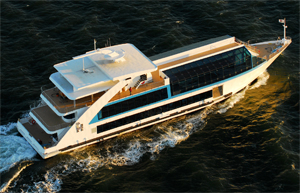An innovative ferry that uses a combination of power sources in order to be more efficient and reduce emissions is now in service.
Hornblower Hybrid, a 168-foot ferry, is powered by Tier 2 diesel engines, batteries, solar panels, wind turbines and a hydrogen fuel cell.
The ferry carries passengers from Battery Park to the Statue of Liberty for the National Park Service. The 600-passenger vessel will also be used for private charters and special events. Its cruising speed is 6 to 7 knots; top speed is 12 knots.
 |
|
Hornblower Hybrid is powered by diesel engines, batteries, solar panels and wind turbines. Once the fuel cell is certified, the ferry will become the first commercial vessel in the nation to run on hydrogen. (Photo courtesy Hornblower Cruises and Events) |
Hornblower Hybrid is likely to be the first commercial vessel in the country to be powered by hydrogen. However, installation of the fuel cell has been delayed. Because hydrogen propulsion has not been used in a ferry before, Hornblower Cruises and Events is still working with the U.S. Coast Guard on certifying the hydrogen fuel cell aspect of the vessel, according to Cameron Clark, director of environmental affairs for Hornblower Cruises.
Clark said the decision was made to get the vessel into service with all but the hydrogen propulsion in place. He expects the hydrogen cell to be installed in the first quarter of 2012. When that happens, "it is just a matter of putting the tank and the fuel cell on the vessel," he said.
The Coast Guard does not have a timetable for approval of the hydrogen propulsion, said Lt. John Walsh, a marine inspector with Coast Guard Sector New York.
"Because it is a novel design with new technology that hasn't been used on a commercial marine vessel in the United States, there are some concerns," Walsh said. "But our goal is to ensure that the vessel is safe." Because this technology is environmentally friendly, the Coast Guard does "support Hornblower's goal toward using the hydrogen technology," he said.
The vessel has two Tier 2 Scania diesel engines that power two Baldor Reliance 700-hp variable speed generators. The vessel has an electric propulsion system consisting of two of Hornblower's power electronic systems that control Baldor Reliance 700-hp induction motors.
There are 192 Odyssey AGM batteries that augment diesel power during high instantaneous loads. The batteries are also charged by a shoreside electric power source while the vessel is at its berth.
The 20-kW solar panel was made by SunPower Corp., of San Jose, Calif. They power navigation equipment, lights and televisions. And there are two Helix Wind 5-kW vertical axis wind turbines.
The hydrogen fuel cell is made by Hydrogenics, based in Mississauga, Ontario. It is a 32-kW proton exchange membrane fuel cell which turns hydrogen into energy by breaking down liquid hydrogen into electricity, heat and distilled water; the electricity then runs an electric motor which charges the 192 batteries. The hydrogen is stored in a carbon-fiber tank.
"We really see this as an opportunity with hydrogen to show that it is safe, to show that it is reliable and that it has the ability to add to the overall power requirements for the vessel," Clark said.
Although the hydrogen fuel cell is a first, in Clark's view, it is the vessel's power management system that is more significant. It allows the captain to switch from one power source to another and to provide AC or DC power at any time. "The power management system on board easily allows for the plug and play of multiple power sources," he said.
But the larger issue is the better use of resources as technology changes the way vessels are powered. As one particular power source becomes outdated, that component can be removed and a new, more efficient source can be added, "as opposed to having to rip out and start over," Clark said.
Not only are conventional retrofits expensive, they are also wasteful, according to Clark.
"It's this whole concept of respecting our resources," he said. "You have this engine that still has life in it. We don't like this idea that you have to rip it out and throw it away."
So it would be possible, for example, to take a Tier 2 engine and, by combining it with other power sources, create a system that allows the vessel to meet Tier 4 emissions standards, he said. "As batteries get better and fuel cells get better, that means the diesel runs less."
Other green features include countertops built from glass and vodka bottles, LED lighting and aluminum for walls and ceilings. The use of aluminum eliminates materials such as wallpaper glue or paints that emit volatile organic compounds.
